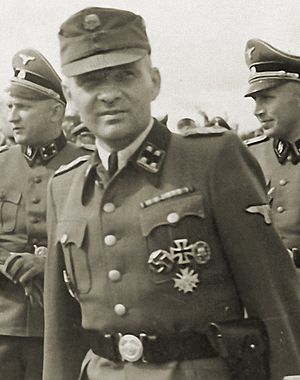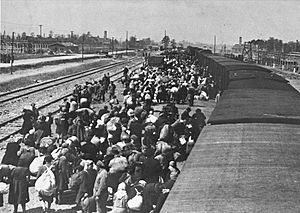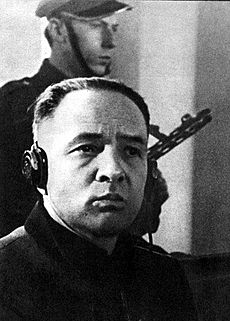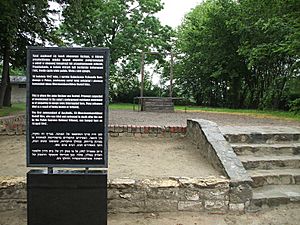Rudolf Höss facts for kids
Quick facts for kids
Rudolf Höss
|
|
|---|---|

SS-Obersturmbannführer Rudolf Höss at Auschwitz
|
|
| Born | 25 November 1900 Strasbourg, Germany (now France) |
| Died | 16 April 1947 (aged 46) Oświęcim, Poland |
| Allegiance | |
| Service/ |
|
| Years of service | At Auschwitz until 1945 |
| Rank | |
| Unit | |
| Commands held | Commandant of Auschwitz concentration camp, 4 May 1940 – 1 December 1943, 8 May 1944 – 18 January 1945 |
| Spouse(s) |
Hedwig Hensel
(m. 1929) |
| Relations |
|
Rudolf Franz Ferdinand Höss (born November 25, 1900 – died April 16, 1947) was a high-ranking member of the Nazi Schutzstaffel (SS) during World War II. He was in charge of the Auschwitz concentration camp for about four years.
During World War II, Nazi Germany, led by Adolf Hitler, planned to kill all Jewish people in Europe. This terrible plan was called the "Final Solution". The Nazis also sent many other groups of people to concentration camps and extermination camps (death camps). As the commander of Auschwitz, Höss tried out and used different ways to kill these people faster. He started using Zyklon B, a gas, to kill prisoners in special rooms called gas chambers. This allowed Nazi soldiers at Auschwitz to murder thousands of people every hour. Under his command, Auschwitz became the largest place in history built for the constant mass murder of human beings.
Höss joined the Nazi Party in 1922 and the SS in 1934. He was in charge of Auschwitz from May 4, 1940, to November 1943, and again from May 8, 1944, to January 18, 1945. Before Nazi Germany lost World War II, more than a million people were killed at Auschwitz. Höss was hanged in 1947 after being found guilty at a trial in Warsaw, Poland.
Contents
Early Life and Military Service
Rudolf Höss was born in Baden-Baden, Germany, on November 25, 1900. He was the oldest of three children and the only son of Franz Xaver Höss and Lina Höss. His family was very Catholic.
Höss wrote in his autobiography that he was briefly kidnapped by Romani people when he was a child.
Höss's father was a former German army officer. He had served in German East Africa, which is now parts of Burundi, Rwanda, and Tanzania. After leaving the army, his father ran a tea and coffee business. He raised his son with strict Catholic beliefs and military discipline. His father wanted Höss to become a Catholic priest. When Höss was a young child, he was often told about sin, guilt, and the need to do penance (to make up for wrongs).
Höss started to turn away from religion as a teenager. This happened after he told a priest his sins in a confession. In Catholicism, a priest is supposed to keep confessions secret. Höss said he began to dislike religion when the priest told Höss's father about something Höss had said. Soon after this, Höss's father died, and Höss began to move towards a military life.
When World War I began, Höss worked briefly in a military hospital. Then, at age 14, he was allowed to join his father's old regiment, the German Army's 21st Regiment of Dragoons. At age 15, he fought with the Ottoman Sixth Army in places like Baghdad and Palestine. While in Turkey, he became a Feldwebel (sergeant). At age 17, he was the youngest non-commissioned officer in the German Army. He was injured three times and got malaria. He received several awards, including the Ottoman Empire's Gallipoli Star and the Iron Cross.
Joining the Nazi Party
After Germany surrendered in November 1918, Höss finished high school. He soon joined nationalist groups that were forming. He first joined the East Prussian Volunteer Corps. Then he joined the Freikorps Rossbach in countries around the Baltic Sea, Silesia, and the Ruhr. Höss took part in attacks against Polish people during the Silesian Uprisings. These were times when Polish people tried to break away from German control. He also took part in attacks against French people during the Occupation of the Ruhr. This was when the Ruhr valley in Germany was occupied by France and Belgium.
Höss joined the Nazi Party in 1922 after hearing Adolf Hitler speak in Munich. Höss was involved in at least one political killing and spent six years in jail for it.
On May 31, 1923, in Mecklenburg, Germany, Höss and other members of the Freikorps killed a local schoolteacher named Walther Kadow. They did this because Martin Bormann wanted them to. Bormann later became Hitler's private secretary. Bormann believed that Kadow had told the French government that Nazi soldier Albert Leo Schlageter was trying to stop French supplies. Schlageter was arrested and killed on May 26, 1923. Soon after, Höss and others, including Bormann, killed Kadow to get revenge. Höss was arrested and tried as the leader of the murder. He was found guilty and sentenced to 10 years in Brandenburg prison. Bormann was sentenced to one year.
Höss was released in July 1928 as part of a general amnesty. He then joined the Völkisch movement ("Artaman League"). This was a nationalist group that supported a clean, farm living style.
On August 17, 1929, Höss married Hedwig Hensel (1908–1989), whom he met in the Artaman League. Between 1930 and 1943, they had five children: two sons (Klaus and Hans-Rudolf) and three daughters (Ingebrigitt, Heidetraut, and Annegret).
Joining the SS and Auschwitz Command
Höss became a member of the SS on April 1, 1934, when Heinrich Himmler encouraged all Nazi men to join. Höss joined the SS-Totenkopfverbände (Death's Head Units) in the same year. He admired Himmler greatly and believed everything Himmler said was "gospel" (truth). He even preferred to display Himmler's picture in his office instead of Hitler's.
Höss was sent to the Dachau concentration camp in December 1934. There, he was a Blockführer ("Block Leader"), meaning he was in charge of one barracks of prisoners. In 1938, Höss was promoted to SS-Hauptsturmführer (Captain) and became an assistant to Hermann Baranowski at the Sachsenhausen concentration camp.
Höss joined the Waffen-SS in 1939 after Nazi Germany invaded Poland. Höss was good at his job, and his bosses suggested he be promoted. By the end of his time there, Höss was in charge of prisoners' belongings.
Auschwitz Commander
On May 1, 1940, Höss was made the commander of Auschwitz. Auschwitz was a combination of concentration camps and an extermination camp (a camp designed for killing). Höss commanded the camp for three and a half years. During this time, he turned the original camp into a huge group of camps called Auschwitz-Birkenau. Höss went to Auschwitz wanting "to do things differently" and make a more efficient camp than Dachau and Sachsenhausen. Höss lived at Auschwitz in a villa with his wife and five children.
The first prisoners at Auschwitz were Soviet prisoners of war and Polish prisoners, including peasants and intellectuals. About 700 of these prisoners arrived in June 1940. The Nazi guards told them they would not live longer than 3 months.
At its largest, Auschwitz included three main camps:
- Auschwitz I: This was the main office for the whole group of camps.
- Auschwitz II (Auschwitz-Birkenau): This was the extermination camp, where people were sent to be killed right away.
- Auschwitz III (Monowitz): This was the forced labor camp, where prisoners were forced to do slave labor for companies like I.G. Farben.
There were also many smaller camps nearby. The Auschwitz complex was built on about 8,000 hectares (20,000 acres) of land. Everyone who lived there before had been forced to leave.
In June 1941, Höss met with SS Commander Heinrich Himmler in Berlin. Himmler told Höss that Hitler had ordered the Final Solution – to kill all Jewish people. Himmler chose Auschwitz as the place where Europe's Jews would be killed. He chose Auschwitz because it was easy to reach by train and had enough space to keep the killings secret. Himmler called the project a "secret Reich matter." Höss later said that "no one was allowed to speak about these matters with any person and that everyone promised upon his life to keep the utmost secrecy."
Höss began testing and improving mass murder methods on September 3, 1941. His experiments made Auschwitz the camp that would kill the most prisoners during the Holocaust. Höss later said that on a normal day at Auschwitz, two to three trains carrying 2,000 prisoners each would arrive daily for four to six weeks. The prisoners were unloaded at the Birkenau death camp. Prisoners who were strong, healthy, and able to work were sent to barracks in Birkenau or other Auschwitz camps. Prisoners who were elderly, very young, sick, or unable to do forced labor were killed in gas chambers, which were disguised as showers. At first, small gassing bunkers were hidden deep in the woods. Later, four large gas chambers and crematoria (places to burn bodies) were built in Birkenau to help the Nazis kill more people faster.
After Auschwitz Command
On November 10, 1943, Arthur Liebehenschel became the commander at Auschwitz. Höss took over Liebehenschel's old job as chairman of a department that ran the concentration camps. Höss also became the assistant to Richard Glücks, who was the inspector of all concentration camps.
On May 8, 1944, Höss returned to Auschwitz to oversee Aktion Höss. During this operation, 430,000 Hungarian Jews were sent to Auschwitz and killed in 56 days. Even the huge facility Höss had built could not handle the enormous number of victims' bodies. The camp's staff had to burn thousands of bodies in open fire pits.
Capture, Trial, and Execution
In the last days of the war, Himmler told Höss to hide among German Navy sailors. Höss avoided arrest for almost a year. He was captured by British soldiers on March 11, 1946, in Gottrupel. He was pretending to be a gardener and called himself Franz Lang. His wife had told the British where Höss was, because she feared her son, Klaus, would be sent to the Soviet Union to be imprisoned or tortured. The British soldiers who captured Höss were led by Hanns Alexander, a young Jewish man from Berlin whose family had to flee to England because of the Nazis. Höss first denied who he was. Alexander noticed his wedding ring and demanded to see it. Höss refused, saying it was stuck. But when Alexander threatened to cut his finger off, Höss removed the ring. It had the names "Rudolf" and "Hedwig" inside. After being questioned, Höss admitted who he really was.
Höss appeared at the Nuremberg Trials on April 15, 1946. There, he explained his crimes in detail. Sworn statements that Rudolf Höss made while in prison were also used in other trials.
In his sworn statement on April 5, 1946, Höss said:
I commanded Auschwitz until December 1, 1943. I believe that at least 2,500,000 victims were killed there by gassing and burning. Another half million died from starvation and disease. This makes a total of about 3,000,000 dead. This number is about 70% or 80% of all people sent to Auschwitz as prisoners. The rest were chosen to be slave laborers. Among those killed were about 20,000 Russian prisoners of war. The rest of the victims included about 100,000 German Jews, and many citizens (mostly Jewish) from Holland, France, Belgium, Poland, Hungary, Czechoslovakia, Greece, and other countries. We killed about 400,000 Hungarian Jews alone at Auschwitz in the summer of 1944.
On May 25, 1946, Höss was given to Polish authorities. The Supreme National Tribunal in Poland tried him for murder. His trial lasted from March 11 to March 29, 1947. During his trial, when accused of murdering three and a half million people, Höss replied, "No. Only two and one half million—the rest died from disease and starvation." Höss was sentenced to death by hanging on April 2, 1947. He was executed on April 16, 1947, next to the crematorium of the former Auschwitz I concentration camp. He was hanged on a gallows built just for his execution, at the location of the camp's Gestapo (secret police) office. Today, a sign at the site reads:
This is where the camp Gestapo was located. Prisoners suspected of being involved in the camp's secret resistance or planning to escape were questioned here. Many prisoners died from being beaten or tortured. The first commander of Auschwitz, SS-Obersturmbannführer Rudolf Höss, who was tried and sentenced to death after the war by the Polish Supreme National Tribunal, was hanged here on April 16, 1947.
Höss wrote his autobiography while waiting to be executed. It was published in 1956 as Kommandant in Auschwitz; autobiographische Aufzeichnungen, and later as Death Dealer: the Memoirs of the SS Kommandant at Auschwitz.
After talking with Höss during the Nuremberg Trials, the American military psychologist Gustave Gilbert wrote:
In all of the discussions, Höss is quite calm and shows no emotion. He shows some late interest in how terrible his crime was, but he gives the impression that it never would have occurred to him if someone hadn't asked him. There is too much lack of feeling to suggest any regret. Even the idea of being hanged does not bother him too much. One gets the general impression of a man who thinks normally, but with a lack of emotion, insensitivity, and lack of empathy that could hardly be more extreme in a truly mentally ill person.
Four days before he was executed, Höss apologized for his crimes in a message to the state prosecutor:
My conscience makes me say the following. In my prison cell, I have sadly realized that I have greatly sinned against humanity. As Commander of Auschwitz, I was responsible for carrying out part of the cruel plans of the 'Third Reich' to destroy people. In doing so, I have caused terrible harm to humanity. I caused unspeakable suffering for the Polish people in particular. I will pay for this with my life. May the Lord God forgive one day what I have done.
Shortly before his execution, Höss returned to the Catholic Church. On April 10, 1947, he received the sacrament of penance (confession) from Friar Władysław Lohn. The next day, the same priest gave Höss Holy Communion as Viaticum (a special communion given to someone who is dying).
Handwritten Confession
Höss's original confession, with his signature, is shown in a glass case at the United States Holocaust Memorial Museum in Washington, D.C. Behind the confession is a photo showing Hungarian Jewish women and children walking to one of the four gas chambers in the Birkenau death camp on May 26, 1944.
Military Ranks and Awards
|
Awards and Decorations
|
Images for kids
-
Commander of Auschwitz I Richard Baer, Auschwitz chief medical officer Josef Mengele and Höss, 1944
See also
 In Spanish: Rudolf Hoss para niños
In Spanish: Rudolf Hoss para niños







